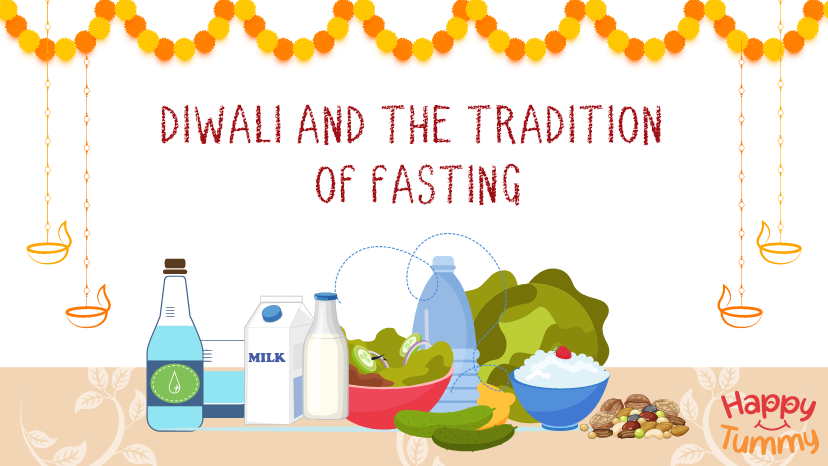Table of Contents
Diwali, the festival of lights, is one of the most celebrated and cherished festivals in India. For many years, it has been an occasion to indulge in the scrumptious feasts at households that symbolize this beautiful festival. However, there’s another side to it – Fasting!
Our grandmother shared stories of how their ancestors had observed fasting during Diwali as a means of spiritual purification and self-reflection.
Well, it’s the time to nourish your soul whole, giving your body a well-deserved break!
In this blog, we will explore the significance of fasting during Diwali, the traditions that surround it, and some tummy-friendly recipes for a balanced and nutritious fasting diet.
Significance of Fasting During Diwali
Both spiritually and culturally, fasting during Diwali holds great significance as it is not just about abstaining from food but a profound practice towards purifying bodies and minds.
Spiritual Cleansing
The fasting process during Diwali extends to not just the physical but spiritual realm as well. Fasting during this time is often seen as the way to cleanse the soul and remove impurities from the body. It allows you to take time for self-reflection and introspection so that you contemplate thoughts and actions.
Traditions and Rituals
Fasting during Diwali is an important symbol in Indian culture and tradition. It is the practice that has been handed down through generations, connecting people to their heritage and roots. The act of fasting is not just an individual choice, but it is a way of paying homage to deities and seeking their blessings.
Digestive Health
In the midst of Diwali’s grand feasts and indulgent sweets, fasting provides a much-needed respite to the digestive system. During fasting, the digestive system focuses on repairing and cleaning itself, which leads to improved digestion and better metabolism. Additionally, when you abstain from heavy or processed food, your body experiences increased energy levels, making you feel more refreshed.
Fasting Traditions during Diwali
As the houses ablaze with light and color, firecrackers Illuminate the sky, and the entire town bathes in the warm golden glow, we realize a sense of fulfillment and connection with Diwali. Let’s explore fasting traditions during Diwali-
- Partial Fasting- This involves abstaining from grains and specific ingredients while consuming water, milk, and non-grained items such as fruits and vegetables. Many people choose to practice partial fasting during Diwali.
- Ekadashi Fasting- Ekadashi is the 11th day of the lunar cycle, which holds significance for some communities during Diwali. People fasting abstain from grains and legumes and instead consume a diet primarily composed of fruits, vegetables, and dairy products. It is believed to emphasize simplicity and purity in dietary choices.
- Nirjala Upavasa (Waterless Fast)- The most rigorous form of fast during Diwali in which individuals observe Nirjala Upavasa. They abstain from not only food but also from water from sunrise to sunset. This waterless fast is a way of testing one’s physical and mental endurance. However, it is approached with caution and awareness of one’s health.
- No Onion and Garlic- Fasting during Diwali includes avoiding certain ingredients like onion and garlic. Such foods are considered Rajasic, meaning they are believed to stimulate passion and restlessness among the individuals consuming them. Hence, they are avoided during fasting on Diwali to maintain a sattvic state of mind.
- Fasting Days- There are some people who fast on a single day, while there are many who fast for several days on the occasion of Diwali. These fasting days are often associated with specific deities and hold cultural and regional significance.
Balanced and Nutritious Fasting Diet
A balanced and nutritious fasting diet is of utmost importance to receive a well-rounded and nutritious set of nutrients while observing the traditions of Diwali.
- Fruits and Nuts: Nuts such as almonds, walnuts, and cashews are nutrient-dense and provide healthy fats, protein, and a dose of energy.
- Root Vegetables: Root vegetables like potatoes, yams, and sweet potatoes are excellent choices for a fasting diet. The fiber content in these vegetables aids in digestion and releases energy steadily.
- Buckwheat (Kuttu) and Amarnath (Rajgira): The pseudo-gains in this highly nutritious and popular choice for fasting are rich in essential amino acids and minerals. Dishes like Kuttu ki roti and Rajgira are not only nutritious but also delicious.
- Sabudana (Sago): It is a popular choice during fasting and is used to prepare dishes like Sabudana Khichdi and Sabudana Kheer. It is easy to digest and provides a quick source of energy, making it an ideal fasting ingredient.
- Dairy Products: Products like milk, yogurt, and paneer are valuable sources of protein and calcium. They maintain bone health during fasting and enhance the fasting meal’s nutritional value.
- Hydration: Staying well-hydrated is essential during fasting. You must consume plenty of water, herbal teas, and coconut water to prevent dehydration and maintain energy levels.
- Avoid Processed Foods: Processed and heavy foods can be heavy on the stomach and lead to discomfort. Also, it is advisable to steer clear of these items.
Tummy-Friendly Fasting Recipes
1. Sabudana Khichdi
Ingredients:
- 1 cup sabudana (sago pearls)
- 2-3 medium-sized potatoes, boiled, peeled, and cubed
- 2-3 tablespoons roasted peanuts, coarsely crushed
- 2-3 green chilies, finely chopped (adjust to your spice preference)
- One teaspoon cumin seeds
- 2-3 tablespoons ghee or peanut oil
- 1/2 teaspoon rock salt (sendha namak), or to taste
- 1/2 teaspoon sugar (optional)
- Juice of 1 lemon
- Fresh coriander leaves, chopped, for garnish
- Grated fresh coconut (optional for garnish)
Step 1: Rinse Sabudana under cold water until the water runs clear and let it sit in the sieve for about 30 minutes to an hour to drain any excess water.
Step 2: Cover the bowl with a clean cloth or a lid and allow the sabudana to rest for about 4-5 hours or overnight.
Step 3: Heat ghee and, add cumin seeds, chopped green chilies, and sauté for a minute.
Step 4: Add vegetables and sabudana, giving a gentle mix for around 7-10 minutes until the sabudana becomes translucent.
Step 5: Add the seasonings and coarsely roasted peanuts. Mix well and serve hot.
2. Fruit Chat during fasting on Diwali
Ingredients:
- Assorted fruits (use your favorites, such as apples, bananas, pomegranate seeds, oranges, grapes, etc.)
- 1/2 cup chopped pineapple (optional)
- 1/2 cup chopped papaya (optional)
- 1/2 cup pomegranate seeds
- 1/2 teaspoon black salt (kala namak), or to taste
- 1/2 teaspoon roasted cumin powder
- 1/4 teaspoon black pepper powder (optional, for some heat)
- Juice of 1 lemon
- Fresh mint leaves, for garnish
Step 1: Wash and peel fruits as needed and cut them into bite-sized pieces.
Step 2: Add black salt, cumin powder, and black pepper powder to the bowl and squeeze the juice of the lemon over the fruits.
Step 3: Gently toss the mixture and cover the fruit chat with the cling foil to refrigerate for at least 30 minutes.
Step 4: Garnish with fresh mint leaves for a burst of freshness and serve as a delicious snack on the side during your Diwali celebration whilst fasting.
3. Rajgira Parantha Recipe during fasting on Diwali
Ingredients:
- 1 cup Rajgira (Amaranth) flour
- 2-3 boiled and mashed potatoes
- 2-3 green chilies, finely chopped (adjust to your spice preference)
- 1 teaspoon cumin seeds
- 1/2 teaspoon rock salt (sendha namak), or to taste
- 1/2 teaspoon black pepper powder (optional, for some heat)
- Ghee (clarified butter) or peanut oil for cooking
- Fresh coriander leaves, chopped, for garnish (optional)
Step 1: Prepare the dough by combining Rajgira flour, boiled and mashed potatoes, finely chopped green chilies, cumin seeds, rock salt, and black pepper.
Step 2: Knead the mixture into a smooth and soft dough and divide it into equal-sized portions to make paranthas.
Step 3: Roll these portions into small balls, flatten the dough ball slightly, and cover it with another piece of plastic or parchment paper.
Step 4: Heat a skillet of a griddle over medium-high heat. Once it is hot, reduce the heat to medium.
Step 5: Cook all the paranthas in the same manner and serve them hot with yogurt, chutney, or any side dish of your choice.
Rajgira Parathas are not only delicious but also a nutritious and wholesome option for those fasting during Diwali.
Final Thoughts
As you embrace the tradition of fasting during Diwali, remember that it is not just about abstaining from certain foods but about nourishing your body and soul. This Diwali, whether you choose to fast or feast, let it be a time of joy, gratitude, and togetherness. In the midst of the celebrations and the twinkling lights, don’t forget to nourish yourself from within. May your Diwali be filled with love, light, and a healthy dose of tradition. Happy Diwali!
FAQs
Abstinence from food or drink, or both for health, religious, and traditional purposes, is generally done by the ladies of the house as fasting on the occasion of Diwali.
Eating sattvic foods and staying hydrated are the basic rules for fasting on Diwali.
Laddoos, Halwa, Sabudana, Dairy products, fruits and vegetables, Protein-rich foods, Barfi, and other foods are traditionally eaten while fasting on Diwali.
While sweets are an important part of the culture and traditions on Diwali, those who fast on the occasion generally eat food without onion and garlic. They consume dairy products, Rajgira, Amarnath flour, and sabudana.















